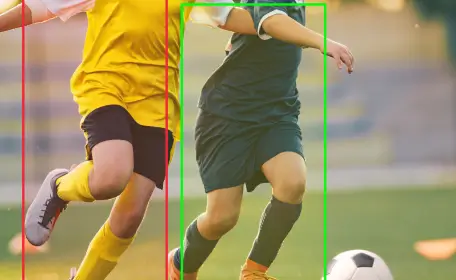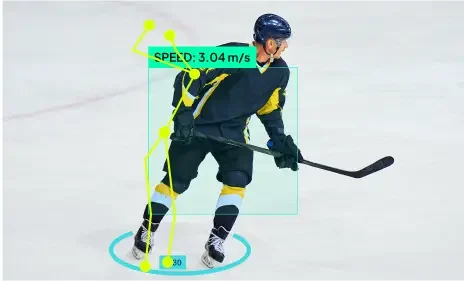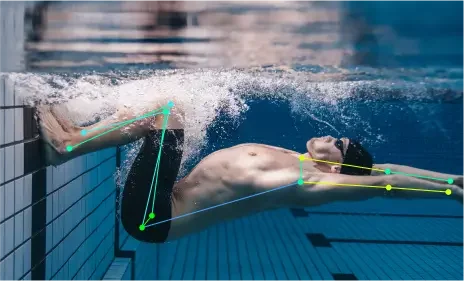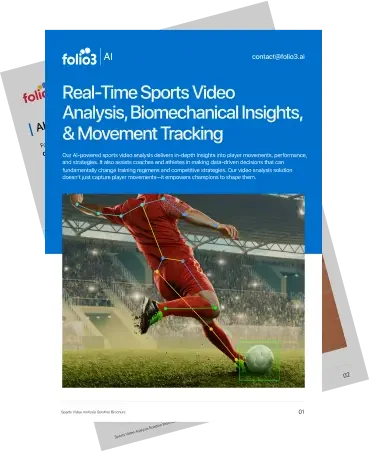AI-Powered Sports Video Analysis Software
Analyze Every Angle, Build Winning Strategies With AI.
As an expert in computer vision and AI, our sports video analysis solutions deliver multi-angle performance breakdowns, tactical insights, and real-time decision support. From elite teams to broadcasters, we help the sports industry turn game footage into high-impact strategies using AI analytics.
The Value You Get from Our Sports Video Analytics
Our sports video analysis provides quintessential and in-depth insights into critical moments during the game, enabling you to identify key opportunities and optimize your strategy.

Coach Smarter with Computer Vision
We use AI-driven pose estimation and action recognition to deliver precision feedback and tailor training to individual player mechanics.

Empower Athletes with Performance Analytics
Deliver athletes with real-time telemetry, biometric trends, and heatmaps to optimize performance and track progression over time.

Accelerate Scouting with Automated Tagging
Use intelligent event detection, pattern recognition, and metadata tagging to identify talent and decode opponent strategies efficiently.

Enhance Team Sync with Intelligent Workflows
We make collaboration easy through AI-generated annotations, video summaries, and shared dashboards for streamlined strategy alignment.
Struggling to Analyze Game Footage Efficiently?
We guarantee you never overlook pivotal moments by delivering sharp, real-time, data-driven insights that facilitate prompt analysis and strategic adjustments.

Cumbersome Manual Tagging
Our AI implements dynamic event detection and automated play classification to minimize analysis latency and maximize workflow efficiency.

Overlooked Insights
With cumulative pattern recognition and deep-learning-driven vision, our system extracts critical moments and hidden trends beyond human perception.

Coaches and Players Lack Actionable Feedback
We provide AI-generated frame-by-frame breakdowns, real-time performance metrics, and dynamic positional tracking for precision training.

Unstructured Footage Chaos
Our intelligent indexing system categorizes footage using AI-driven player tracking, tactical segmentation, and event-based metadata for instant retrieval.

Performance Stagnation
AI-powered analytics detect micro-patterns in play, offering adaptive insights and predictive modeling to drive continuous improvement.

Fragmented Team Communication
Our platform fosters strategic alignment through AI-curated visual annotations, auto-generated summaries, and shareable dynamic play clips.
Powerful Features Designed for Coaches, Analysts, & Athletes
In the fiercely competitive world of professional sports, leveraging advanced data analytics is crucial for securing victories. Integrating AI technology elevates this process, offering unparalleled speed, precision, and accessibility.

Player Performance Analysis
Our software provides detailed insights into player performance by analyzing key metrics such as speed, agility, and endurance. This feature helps coaches and teams identify strengths and areas for improvement, driving enhanced training and game strategies.
Movement Tracking
Track and monitor every player’s movement on the field with precision. Our software captures and analyzes player positions, movement patterns, and dynamics, enabling teams to understand the game flow and optimize tactical decisions in real time.

Tactical Analysis
Gain a deeper understanding of team strategies and opponent tactics through comprehensive video analysis. Our software breaks down plays, identifies patterns, and provides insights into how to counter opposing strategies effectively.

Injury Prevention and Recovery
Our software helps minimize injury risks by analyzing players’ biomechanics and movement patterns. By identifying potential areas of strain or improper technique, coaches can make informed decisions to adjust training regimens and ensure player safety.

Positional Awareness
Enhance your team’s on-field positioning and awareness by analyzing spatial dynamics. Our software provides insights into player spacing, formations, and positional play, allowing for better coordination and tactical execution during matches.

Game Flow Visualization
Visualize and review key moments of the game with intuitive video playback and analysis tools. Our software highlights significant plays, player interactions, and pivotal moments, making it easier to evaluate performance and make data-driven decisions.

Performance Benchmarking
Benchmark individual and team performance against predefined metrics or past performances. This feature allows for consistent performance evaluation and progress tracking, helping teams set goals and measure improvement over time.

Biomechanical Analysis
Utilize advanced AI-driven biomechanical analysis to study players' movement mechanics in detail. Our software assesses body posture, joint angles, and overall movement efficiency, helping coaches optimize player form, improve performance, and reduce injury risks.

Swing Analysis
Perfect for sports like baseball, golf, and tennis, our swing analysis feature provides detailed insights into swing mechanics, analyzing angles, timing, and force. This helps athletes improve their form, enhance their power, and achieve better results on the field or court.
Monitor, Analyze, and Win with Confidence
Track every player's move with precision. Use computer vision's abilities to improve your sports team's performance, from pose estimation and movement tracking to play performance analysis.
Old School vs. Next-Level
| ❌ Before | ✅ After (With Our Software) | |
|---|---|---|
| Time Spent Reviewing | 4–6 hours per game | Under 30 minutes with auto-tagging |
| Tagging Events | Manual, error-prone | AI-powered, instant, and accurate |
| Player Feedback | Verbal & scattered | Visual, structured, and data-backed |
| Team Communication | Disjointed & delayed | Centralized with shareable clips |
| Performance Tracking | Based on memory | Based on heatmaps, movement, and metrics |
| Scouting/Recruiting | Based on highlight reels | Data-driven insights and trends |
| Access Anywhere | Files stored locally | Cloud-based access on any device |
| Cost of Error | High — missed insights | Low — full visibility every time |
Designed for Every Level, Every Sport
Our AI-powered deep learning and real-time video analysis deliver precision granular insights tailored for every industry for strong team bonding and coordination.

Track player positions, passes, shots, and overall field coverage. Our AI helps coaches analyze offensive and defensive formations, identify space utilization, and refine strategies such as pressing, counter-attacks, and set-piece plays to enhance team performance.

Cricket Analysis Software
Optimize batting, bowling, and fielding performance with AI-driven metrics. Our software provides swing analysis for batters, biomechanics analysis for bowlers, and insights into field positioning, helping teams enhance their decision-making.

Basketball Analysis Software
Track movement on the court, including player rotations, defensive alignments, and shot selection. Our AI can identify key moments, break down fast breaks, and analyze spacing to assist with playmaking and defense optimization. Gain insights into player fatigue and injury prevention, too.

Lacrosse Analysis Software
Improve stick handling, positioning, and overall field dynamics by leveraging detailed movement and performance metrics. Our AI-powered software identifies passing lanes, player movement patterns, and defensive positioning to boost offensive and defensive strategies

Tennis Analysis Software
Benefit from in-depth swing analysis, tracking shot angles, ball speed, and player positioning. Our AI identifies key areas for improvement in technique, endurance, and positioning during rallies, helping players sharpen their game and develop better tactics.

Volleyball Analysis Software
Analyze player movements during spikes, serves, blocks, and defensive plays. Our software tracks positional dynamics, set-up patterns, and rotational movements, offering actionable insights to improve coordination, communication, and overall team play.

Golf Analysis Software
Refine your game swing with our AI-powered swing analysis. It tracks swing mechanics, club angles, and ball trajectory, providing insights to optimize form and increase precision. Our software also offers biomechanical analysis to reduce injury risk and improve long-term performance.

Hockey Analysis Software (Ice and Field)
Our platform captures puck control, shift changes, team formations, and breakouts, providing critical insights for evaluating both individual performance and tactical execution.

Swimming Video Analysis Software
We evaluate stroke mechanics, turn speed, body alignment, and underwater phases to help swimmers and coaches improve their technique and reduce drag effectively.

AI Gait Analysis
Our AI measures joint articulation, stride patterns, and symmetry to support performance optimization, injury prevention, and rehabilitation for athletes and sports professionals.

Baseball Video Analysis Software
We deliver detailed swing analysis, pitch recognition, and defensive tracking through automated video breakdowns that assist in scouting, training, and in-game decisions.
Refine Your Strategy With Precise Sports Insights From Every Possible Angle
Learn more about our sports video analysis standard features.

Frequently Asked Questions
How fast is the video processing?
It’s almost real-time, with processing speeds that allow immediate analysis during the game.
Is this for individual players too?
Yes, it tracks individual player performance, focusing on strengths, weaknesses, and key moments.
Can I share clips with my team?
Absolutely! You can easily share clips and insights directly with your team for review.



















